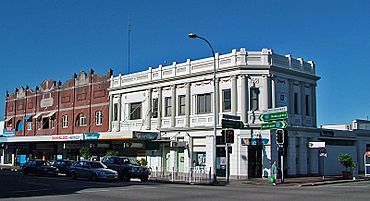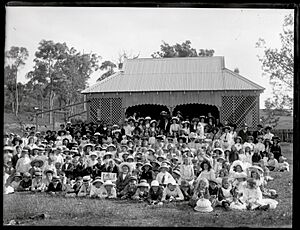Mayfield, New South Wales facts for kids
Quick facts for kids MayfieldNewcastle, New South Wales |
|||||||||||||||
|---|---|---|---|---|---|---|---|---|---|---|---|---|---|---|---|

Shops on the corner of Hanbury Street and Maitland Road
|
|||||||||||||||
| Population | 9,314 (2016 census) | ||||||||||||||
| • Density | 1,150/km2 (3,000/sq mi) | ||||||||||||||
| Established | 1880s | ||||||||||||||
| Postcode(s) | 2304 | ||||||||||||||
| Area | 8.1 km2 (3.1 sq mi) | ||||||||||||||
| Location | 6 km (4 mi) NW of Newcastle | ||||||||||||||
| LGA(s) | City of Newcastle | ||||||||||||||
| Parish | Newcastle | ||||||||||||||
| State electorate(s) | Newcastle | ||||||||||||||
| Federal Division(s) | Newcastle | ||||||||||||||
|
|||||||||||||||
Mayfield is a suburb located in the north-western part of Newcastle, New South Wales. It was named after Ada May, who was born in 1874. She was the daughter of John Scholey, a big landowner in the area. Mayfield is bordered by the Hunter River to the north and the Main Northern railway line to the south.
Contents
Early History of Mayfield
First People of the Land
The Awabakal people are the original custodians of the land where Mayfield is now found. Evidence of their long history here was first found in 1925. A man named Daniel F. Cooksey discovered ancient stone tools. These tools, including one called an Elouera, were found near the Hunter River.
W. W. Thorpe, an expert from the Australian Museum, confirmed these important finds in 1928. Cooksey's detailed notes and reports are kept at the University of Newcastle. They help us learn about the area's rich Aboriginal past.
How Mayfield Grew
Much of Mayfield was once called North Waratah. It was part of a larger area known as the Municipality of Waratah. This area became an official municipality in 1871. John Scholey, the landowner who named Mayfield, was also the Mayor of Waratah three times.
In 1938, many smaller towns, including Waratah, joined together. They formed the "City of Greater Newcastle." Before Mayfield was divided into lots for sale, it was mostly forests and fields. However, a church called St Andrew's opened in North Waratah as early as 1861. A new St Andrew's church was built in Mayfield in 1924.
Mayfield was once a lovely garden suburb on the edge of Newcastle. By 1901, it had a Roman Catholic monastery. There were also beautiful Victorian mansions. These homes belonged to important business people and lawyers. N.B. Creer, who was Mayor of Waratah three times, owned one.
John Scholey built his own home, "Mayfield House," using sandstone brought from England. Charles Upfold, a soap maker, built a large mansion on Crebert Street. His friend Scholey gave him the land. This mansion was later sold to biscuit maker William Arnott. He named it "Arnott Holme." Arnott then sold it in 1898 to Isaac Winn. Winn owned a large department store in Newcastle. He renamed the mansion "Winn Court."
In the 1920s, BHP built a grand mansion on Crebert Street for their General Manager. It had huge gardens. Today, it is privately owned and called The Bella Vista. It is often used for weddings and other events.
Industry Comes to Mayfield
The Steel Works Arrive
In 1896, BHP bought land near the river in Mayfield East. They planned to build smelters there. In 1910, they decided to build a huge steel works and foundries. This included a large blast furnace and other steel-making equipment. They also built coke ovens to supply fuel for the furnaces.
This location was perfect for the steel works. It had easy access to both rail and shipping for transport. It was also close to the Newcastle and South Maitland coalfields. The steel works used a lot of coal, about 30,000 tons every week in 1947!
Work began in January 1913 to prepare the land. The New South Wales Government helped by making sure the river channel was deep enough for ships. The blast furnace started working in March 1915.
Growth and Change
Other industries soon followed. These included John Lysaght & Co., which made galvanized iron (1921). Rylands Bros made wire, nails, and other metal products. Stewarts & Lloyds made tubes (1934), and the Newcastle Chemical Co. started in 1940. All these companies set up next to the steel works.
Because of all this industry, Mayfield started to change. It lost its fancy image as a garden suburb. Most of the new houses built during and after World War I were for people who worked in these big factories.
A large part of the Steel Works closed down in September 1999. This affected many nearby businesses. However, some steel mills, like Australian Tube Mills, Newcastle Wire Mill, and Rod Mill, are still working today. They are part of the Liberty Steel group.
Gallery






















